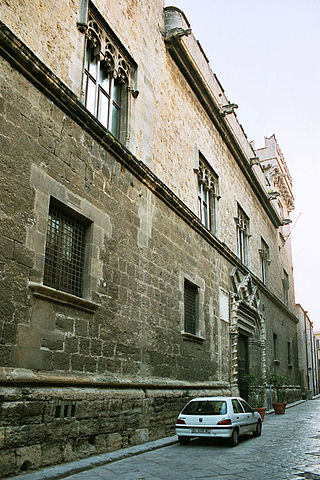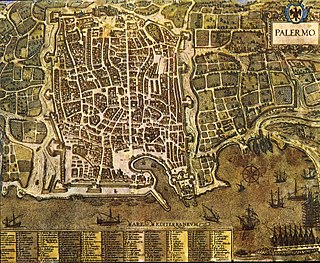
Palermo is a city in southern Italy, the capital of both the autonomous region of Sicily and the Metropolitan City of Palermo, the city's surrounding metropolitan province. The city is noted for its history, culture, architecture and gastronomy, playing an important role throughout much of its existence; it is over 2,700 years old. Palermo is in the northwest of the island of Sicily, by the Gulf of Palermo in the Tyrrhenian Sea.

The Province of Palermo was a province in the autonomous region of Sicily, a major island in Southern Italy. Its capital was the city of Palermo. On 4 August 2015, it was replaced by the Metropolitan City of Palermo.

The Teatro Massimo Vittorio Emanuele is an opera house and opera company located on the Piazza Verdi in Palermo, Sicily. It was dedicated to King Victor Emanuel II. It is the biggest in Italy, and one of the largest of Europe, renowned for its perfect acoustics.

Ferdinando Fuga was an Italian architect who was born in Florence, and is known for his work in Rome and Naples. Much of his early work was in Rome, notably, the Palazzo della Consulta (1732–7) at the Quirinal, the Palazzo Corsini (1736–54), the façade of the Santa Maria Maggiore (1741–3), and the Church of Sant'Apollinare (1742–8). He later moved to Naples and notably designed the Albergo de'Poveri (1751–81), the façade of the Church of the Gerolamini, and that of the Palazzo Giordano.

Chiaia is an affluent neighbourhood on the seafront in Naples, Italy, bounded by Piazza Vittoria on the east and Mergellina on the west. Chiaia is one of the wealthiest districts in Naples, and many luxury brands have shops on its main street. It is also home to a business school and a medical school, as well as other public schools.

BBPR was an architectural partnership founded in Milan, Italy in 1932.

Piazza del Duomo is located in the heart of the historic center of Florence. It is one of the most visited places in Europe and the world and in Florence, the most visited area of the city. The square contains Florence Cathedral with the Cupola del Brunelleschi, the Giotto's Campanile, the Florence Baptistery, the Loggia del Bigallo, the Opera del Duomo Museum, and the Arcivescovile and Canonici's palace. The west zone of this square is called Piazza San Giovanni.

Palazzo Abatellis is a palazzo in Palermo, Sicily, southern Italy, located in the Kalsa quarter. It is home to the Galleria Regionale della Sicilia, the Gallery of Art for the Sicilian region.

Villas and palaces in Milan are used to indicate public and private buildings in Milan of particular artistic and architectural value. Milan has always been an important centre with regard to the construction of historical villas and palaces, ranging from the Romanesque to the neo-Gothic, from Baroque to Rococo.

The Palazzo Riso, or RISO, Museo d’Arte Contemporanea della Sicilia, is a regional contemporary art museum located in the ancient Corso Vittorio Emanuele, Palermo, Italy.

Piazza della Scala is a pedestrian central square of Milan, Italy, connected to the main square of Milan, Piazza del Duomo, by the Galleria Vittorio Emanuele II passage. It is named after the renowned Teatro alla Scala opera house, which occupies the north-western side of the square; the building actually includes both the opera house and the Museo Teatrale alla Scala, dedicated to the history of La Scala and opera in general. On the opposite side to "La Scala", to the south-east, is the facade of Palazzo Marino, Milan's city hall. Another relevant building on the square, on the north-eastern side, is the Palazzo della Banca Commerciale Italiana. The south-western side of the square has the entry to the Galleria Vittorio Emanuele as well as Palazzo Beltrami. Most of the architecture of the square is due to architect Luca Beltrami, who designed the eponymous palace, the facade of Palazzo Marino, and the Banca Commerciale Italiana building. The centre of the square is marked by the monument of Leonardo da Vinci by sculptor Pietro Magni (1872).

The Palazzo Vecchio de' Medici, also called the Palazzo della Prefettura is a Gothic revival-style palace located on Piazza Giuseppe Mazzini #7, in the city of Pisa, region of Tuscany, Italy.

The Politeama Theatre is a theatre of Palermo. It is located in the central Piazza Ruggero Settimo and represents the second most important theatre of the city after the Teatro Massimo. It houses the Orchestra Sinfonica Siciliana.

The Cassaro is the most ancient street of Palermo. From the late 16th century the street also had the name Via Toledo. Following the unification of Italy, it was officially renamed Via Vittorio Emanuele II, but the old and distinctive name is still in use. The street is rooted in the age of the foundation of Palermo by the Phoenicians. It provides access to a number of important sights, including the Royal Palace and the Cathedral, two UNESCO World Heritage Sites.

Victory Square is a square of Palermo. It is located between the Royal Palace and the Palermo Cathedral, down the Cassaro street, in the quarter of the Albergaria, within the historic centre of Palermo. The square is dominated by the great garden of Villa Bonanno.

The following outline is provided as an overview of and topical guide to Palermo:

The Palazzo delle Poste or Palazzo Postale is a monumental government building, executed in the stripped classicism architectural style of the 1920s, originally intended as the mail and telegraph center, located on Via Roma #320, in the quarter of Castellamare in Palermo, region of Sicily, Italy. The modern building is bordered on the north by the church of the Sant'Ignazio all'Olivella and the adjacent Regional Archeologic Museum, while Piazza San Domenico is a few blocks to the south.

The Palazzo Alliata di Villafranca is former aristocratic mansion, now converted into a museum, located just off Via Vittorio Emanuele facing the Piazza Bologni which opens two blocks west of the Quattro Canti intersection, in the ancient quarter of the Albergaria of the city of Palermo, region of Sicily, Italy.

Madonna dei Rimedi is a Baroque-style, Roman Catholic Sanctuary-church, established and still affiliated with the Discalced Carmelite order, located on Piazza Indipendenza # 9, in Palermo, region of Sicily, Italy.




















